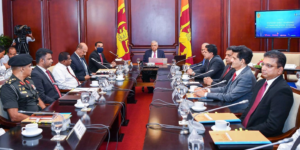Physical Address
23,24,25 & 26, 2nd Floor, Software Technology Park India, Opp: Garware Stadium,MIDC, Chikalthana, Aurangabad, Maharashtra – 431001 India
Physical Address
23,24,25 & 26, 2nd Floor, Software Technology Park India, Opp: Garware Stadium,MIDC, Chikalthana, Aurangabad, Maharashtra – 431001 India

On 19th December, a sophisticated disaster early warning system was officially launched in Sri Lanka with the supremacy of President Ranil Wickramasinghe. This disaster early warning system was a collaborative effort of the Disaster Management Centre, Sri Lanka Telecommunication and major telephone service providers in the country, including SLT Mobitel, Hutch, Dialog and Airtel.
The Memorandum of Understanding formalising this strategic initiative was signed in the President’s office on the 19th. Director General of the Disaster Management Centre, Major General S. Ranasinghe (Retired), and Director General of the Sri Lanka Telecommunication Regulatory Commission, Mr. Madhushanka Dissanayake, were signatories to the MoU. Notable stakeholders include the Group Chief Executive Officer of Dialog Axiata, Mr Supun Weerasinghe, Group Chief Executive Officer of Sri Lanka Telecom, Mr Janaka R. Abeysinghe, Chief Executive Officer of Bharti Airtel Lanka, Mr Ashish Chandra, Chief Operating Officer of Mobitel Pvt. Ltd. Mr Sudarshan Giganage and Acting Chief Executive Officer of Hutchison Telecommunications Lanka. Mr. Sumitra Gupta, Pvt. Ltd., was involved in the signing ceremony.

The high-profile event was attended by key dignitaries, including State Minister for Defence Mr Pramitha Bandara Thennakoon, President’s Senior Advisor on National Security and Chief of Presidential Staff Mr Sagala Rathnayake, Secretary to the Defence Ministry General Kamal Gunarathne (Retired) and Director of the Disaster Management Centre Brigadier T.C. Harasgama and Mr. Pradeep Kodippili was among them.

Early Warning Systems
An early warning system is a special notification given to citizens in risky areas before a disaster. These notifications can help individuals, communities, and organisations be aware of threats and allow them to take appropriate measures to minimise the potential impact of disasters through planning and preparedness activities.
Disaster early warning systems use technology and data to detect and alert communities about impending natural disasters. These systems aim to provide timely information to help people evacuate or take protective measures, reducing the impact of disasters on human lives and property. Advances in sensor technology, satellite monitoring and communication networks contribute to the effectiveness of these warning systems.
Typically, sirens, loudspeakers, SMS, TV broadcasts, Radio data services, and information billboards are general early disaster warning systems. But this new warning system is more effective and more functional. Here for more details on disaster early warning systems.
The diagram below shows all the requirements and points needed in planning a disaster early warning system to take action to save lives and properties by giving accurate details to all the individuals in society. This diagram is based on the United Nations Disaster Risk Reduction Office’s principles of developing an early warning system.

According to this, four special elements should be addressed in planning an effective early disaster warning system.
There was also a typical disaster early warning system in Sri Lanka for years, especially after the 2004 Tsunami. However, from the general mechanism, with technology development, Sri Lanka has updated this system with advanced technological mechanisms.
State-of-the-Art Disaster Early Warning System in Sri Lanka
The primary object of the State-of-the-Art Early Warning System is to ensure the safety and well-being of Sri Lankan citizens amidst disasters, including those caused by weather and climate changes, by strengthening the existing disaster management mechanism in Sri Lanka. This new technology mainly has targeted disasters, especially tsunamis, which cover almost 60000 mobile and landline numbers in 14 districts with a high risk for disasters.
Sri Lanka is a country that is more vulnerable to disasters. So, a proper and developed early disaster warning system is essential to the country.
This system has been designed to deliver a warning alert through the phone to the user with a distinctive ‘Ring Tone’ notification accompanied by a siren sound. This mechanism is considered more effective, especially during night hours.
This new disaster early warning system in Sri Lanka seems to be applicable very well to the UN’s principles of developing disaster early warning systems. This was designed with an understanding of the behaviour of typical Sri Lankans with technology.
Scheduled for a public rollout on ‘National Security Day’ on December 26th, the system’s scope is anticipated to expand, evolving into a comprehensive multi-disaster early warning mechanism. This expansion aims to include landslides and floods, further enhancing its utility and impact.
This can be considered a massive step in Sri Lanka’s technological development in disaster management. This system should be developed further to increase the protection and awareness of the disaster through the community. Also, this State-of-the-Art Disaster Early Warning System significantly impacts the Sri Lankan community while facing disasters and climate change.
-With Inputs from Mihiri Saparamadhu–